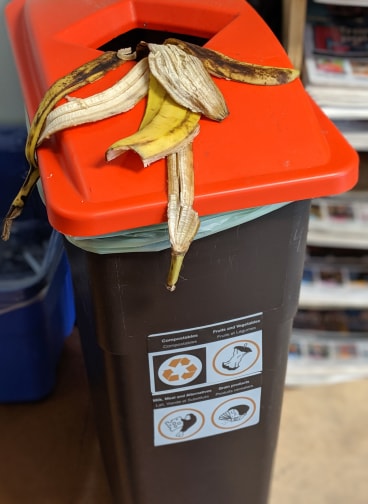We have all surely crossed paths with those orange-capped garbage cans that decorate Concordia’s campuses. Little hubs for our biodegradable waste, the list of things we can put in them is particular but easy!
If your trash is made from plants, like those brown paper bags greasy fries from a favorite burger joint are tossed in, plop it in! If your lunch was too big, the bins are perfect orphanages for leftovers you’ll abandon. It sucks that you cannot finish your grandmother’s pasta, but the compost will happily handle that for you. Napkins covered in mascara after crying over an assignment? A banana that got squashed at the bottom of your bag? Toenails? Yup, all of those organic-based items can go in, but it’s important to know exactly how composting works and why we bother with it.
It all comes down to microbes. Eons ago, before you, or I, or any of our ancestors stressed over school, there were tiny lifeforms on Earth that thrived without using oxygen. They are called anaerobes. Eventually, oxygen users like us, known as aerobes, joined the scene hundreds of millions of years later. We and anaerobes now strut across the same runway that is the planet, but humans have to be careful. No, you’re right, anaerobes won’t throw marbles under our feet while we pose, but they do dangerous things with our trash!
When you put that bite of your grandmother’s pasta in the general garbage, it all gets closed up in a plastic bag. This prevents airflow and creates a low oxygen environment that gives anaerobes a chance to grow. Contained in a perfect microcosm, they break down your food and produce methane as a byproduct. That’s bad because methane is a greenhouse gas; it absorbs the sun’s heat and consequently contributes to climate change.
Aerobes also biodegrade food, but make carbon dioxide instead of methane. Carbon dioxide is a greenhouse gas as well, but soaks up way less solar radiation. In addition to that, aerobes manage to eliminate toxicity better and produce less of a rotten smell than anaerobes.
So, how do we get our food to be handled by aerobes instead of anaerobes? By composting!
Composts are set up to maintain airflow. Aerobes get the oxygen they need to live and this type of environment blocks anaerobic expansion. All it can take to sustain the right aerobic atmosphere is a simple stir of a container. With composts, we can make humus. Before you take your pita out, know that humus isn’t your favorite Middle Eastern spread (that’s actually hummus). Humus is a term used to reference dirt achieved from rotting organics. Those orange bins on campus are a way to take remaining glop and make beautiful, nutrient soil. Letting anaerobes process our leftovers goes the opposite way, tending to make waste more hazardous.
It’s worth noting that some compost processing sites actually embrace anaerobe disadvantages to harvest their methane. Humans burn the gas for heat and electricity. Despite not being clean energy, at least our species can use it and cause climate change instead of not using it and warming the globe anyway. If you think of all the landfills on our planet, there is a lot of food rotting without being exploited.
In a world piling up with trash, humans are faced with more and more complexities surrounding what to do with it. The U.S. Environmental Protection Agency reported, “Pound for pound, the comparative impact of [methane] is more than 25 times greater than [carbon dioxide] over a 100-year period.” Concordia’s orange bins are a game of anaerobes vs. aerobes. These days, the seemingly simple act of throwing away a teabag is actually an influential decision that’ll shape history.
Featured photo by Virginie Ann




